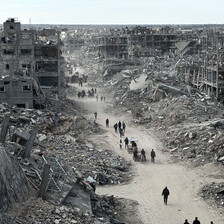The Electronic Intifada 2 February 2025

Displaced Palestinians return to Beit Lahiya, northern Gaza Strip, on 29 January.
ActiveStillsAhmad Ridwan was pushing the wheelchair, used by his 88-year-old grandfather Saadi, while carrying a bag with some clothes and a few other belongings.
They were heading back to Jabaliya refugee camp, northern Gaza, after more than a year of forced displacement.
Ahmad, 27, looked exhausted.
They had set out from the Nuseirat area of central Gaza, early in the morning. Ahmad would have to walk a distance of about 15 kilometers before reaching their destination.
“The route is difficult and rough,” Ahmad told The Electronic Intifada. “The streets [along the way] were destroyed and there were a lot of debris and deep craters caused by the airstrikes.”
Despite the conditions, “we were determined to continue our journey and reach our home,” he added.
Before their displacement, Ahmad and his family had lived in a five-story building. With Israel laying waste to Jabaliya, that building was damaged severely.
“I’m happy because we can restore two rooms to live in,” he said. “That’s much better than living in a tent.”
“The situation is extremely tough,” he added. “The scale of destruction is unimaginable. There are no services – no water, no electricity, no sewage systems. But the fact that we are returning to the north means a lot to us. We will rebuild our lives from scratch.”
Once the ceasefire came into effect on 19 January, Saadi, Ahmad’s grandfather, insisted that the family return to Jabaliya promptly. Delaying the journey could prolong their displacement, Saadi argued, as he feared that the ceasefire would not hold.
As a child, Saadi had been uprooted from his original home during the Nakba, the ethnic cleansing of Palestine between 1947 and 1949. As he was never allowed to return there, he was adamant that his 21st century displacement must end.
Israel only permitted displaced people to head back towards northern Gaza more than a week after the ceasefire went into effect. Hundreds of thousands have headed back to their homes in Gaza since then.
“Deep sorrow”
Abu Qusay, a 38-year-old nurse, was among them.
“I will never leave my home again, no matter what happens,” he said. “I would rather stay and die in it than be displaced again, no matter the danger.”
“Despite the extensive destruction in Gaza, the feeling of returning and reuniting with loved ones is indescribable,” he added.
Many undertook the journey even though their homes in the northern part of Gaza had been destroyed.
Muhammad al-Dali, 38, walked with his mother, his wife and four of their daughters.
“There is no home to return to,” he said. “I don’t know what to do in the midst of all this destruction. All we want, all that has occupied our thoughts, is to return to the north.”
While everyone in Gaza has gone through horrors over the past 15 months, the experience of Aya Hassouna was particularly traumatic.
Having fled northern Gaza for the south, the tent in which her family sought shelter was attacked by Israel. Ayeh’s journalist husband Abdallah al-Susi and their children, Hamza and Raghad, aged 4 and 2, respectively, were killed in an Israeli attack in August.
Aya went back to the north on her own.
“I feel a deep sorrow, going back alone – without my husband and children,” she said.
She was hoping that reuniting with her parents would relieve a small amount of her pain.
Gaza is in ruins. More than 50 million tons of rubble have to be removed. Doing so could take two decades, according to a United Nations estimate.
As well as all the damage that will have to be repaired, Gaza’s people have to try and cope in a situation involving an incalculable level of grief and shock.
Achieving even a semblance of normality is an enormous task after a genocidal war. The sense of determination shown by people on their journey home indicates that they have already begun that task.
Fedaa al-Qedra is a journalist in Gaza.





